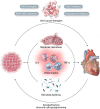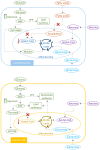Mechanisms shared between cancer, heart failure, and targeted anti-cancer therapies
- PMID: 36004495
- PMCID: PMC9897696
- DOI: 10.1093/cvr/cvac132
Mechanisms shared between cancer, heart failure, and targeted anti-cancer therapies
Abstract
Heart failure (HF) and cancer are the leading causes of death worldwide and accumulating evidence demonstrates that HF and cancer affect one another in a bidirectional way. Patients with HF are at increased risk for developing cancer, and HF is associated with accelerated tumour growth. The presence of malignancy may induce systemic metabolic, inflammatory, and microbial alterations resulting in impaired cardiac function. In addition to pathophysiologic mechanisms that are shared between cancer and HF, overlaps also exist between pathways required for normal cardiac physiology and for tumour growth. Therefore, these overlaps may also explain the increased risk for cardiotoxicity and HF as a result of targeted anti-cancer therapies. This review provides an overview of mechanisms involved in the bidirectional connection between HF and cancer, specifically focusing upon current 'hot-topics' in these shared mechanisms. It subsequently describes targeted anti-cancer therapies with cardiotoxic potential as a result of overlap between their anti-cancer targets and pathways required for normal cardiac function.
Keywords: Cancer; Cardiotoxic drugs; Heart failure; Mechanisms.
© The Author(s) 2022. Published by Oxford University Press on behalf of the European Society of Cardiology.
Conflict of interest statement
Conflicts of interest: The University of Glasgow, which employs N.N.L. and C.G. has received research grant funding from Roche Diagnostics, AstraZeneca and Boehringer Ingelheim (outside the submitted work). N.N.L. has received speaker’s fees/advisory board fees from Roche, Pharmacosmos, AstraZeneca and Novartis. The UMCG, which employs S.d.W. and R.A.d.B., has received research grants and/or fees from AstraZeneca, Abbott, Boehringer Ingelheim, Cardior Pharmaceuticals Gmbh, Ionis Pharmaceuticals, Inc., Novo Nordisk, and Roche (outside the submitted work). R.A.d.B. received speaker fees from Abbott, AstraZeneca, Bayer, Novartis, and Roche (outside the submitted work).
Figures



Similar articles
-
Models of Heart Failure Based on the Cardiotoxicity of Anticancer Drugs.J Card Fail. 2016 Jun;22(6):449-58. doi: 10.1016/j.cardfail.2016.04.008. Epub 2016 Apr 18. J Card Fail. 2016. PMID: 27103426 Review.
-
Insights Into Heart-Tumor Interactions in Heart Failure.Circ Res. 2025 May 23;136(11):1262-1285. doi: 10.1161/CIRCRESAHA.124.325490. Epub 2025 May 22. Circ Res. 2025. PMID: 40403117 Review.
-
Cardiotoxicity and Heart Failure: Lessons from Human-Induced Pluripotent Stem Cell-Derived Cardiomyocytes and Anticancer Drugs.Cells. 2020 Apr 17;9(4):1001. doi: 10.3390/cells9041001. Cells. 2020. PMID: 32316481 Free PMC article. Review.
-
Cancer Risk in the Heart Failure Population: Epidemiology, Mechanisms, and Clinical Implications.Curr Oncol Rep. 2020 Dec 2;23(1):7. doi: 10.1007/s11912-020-00990-z. Curr Oncol Rep. 2020. PMID: 33263821 Free PMC article. Review.
-
New-Onset Cancer in the HF Population: Epidemiology, Pathophysiology, and Clinical Management.Curr Heart Fail Rep. 2021 Aug;18(4):191-199. doi: 10.1007/s11897-021-00517-y. Epub 2021 Jun 28. Curr Heart Fail Rep. 2021. PMID: 34181210 Free PMC article. Review.
Cited by
-
Cardiovascular Safety in Oncology Clinical Trials: JACC: CardioOncology Primer.JACC CardioOncol. 2025 Feb;7(2):83-95. doi: 10.1016/j.jaccao.2024.09.014. Epub 2024 Dec 10. JACC CardioOncol. 2025. PMID: 39967209 Free PMC article. Review.
-
Small Extracellular Vesicles From Infarcted and Failing Heart Accelerate Tumor Growth.Circulation. 2024 May 28;149(22):1729-1748. doi: 10.1161/CIRCULATIONAHA.123.066911. Epub 2024 Mar 15. Circulation. 2024. PMID: 38487879 Free PMC article.
-
Recent advances in pluripotent stem cell-derived cardiac organoids and heart-on-chip applications for studying anti-cancer drug-induced cardiotoxicity.Cell Biol Toxicol. 2023 Dec;39(6):2527-2549. doi: 10.1007/s10565-023-09835-4. Epub 2023 Oct 27. Cell Biol Toxicol. 2023. PMID: 37889357 Review.
-
Multifactorial Diseases of the Heart, Kidneys, Lungs, and Liver and Incident Cancer: Epidemiology and Shared Mechanisms.Cancers (Basel). 2023 Jan 25;15(3):729. doi: 10.3390/cancers15030729. Cancers (Basel). 2023. PMID: 36765688 Free PMC article. Review.
-
Association between heart failure and the incidence of cancer: a systematic review and meta-analysis.Eur Heart J Open. 2023 Aug 3;3(5):oead073. doi: 10.1093/ehjopen/oead073. eCollection 2023 Sep. Eur Heart J Open. 2023. PMID: 37818223 Free PMC article.
References
-
- Moliner P, Lupón J, de Antonio M, Domingo M, Santiago-Vacas E, Zamora E, Cediel G, Santesmases J, Díez-Quevedo C, Troya MI, Boldó M, Altmir S, Alonso N, González B, Núñez J, Bayes-Genis A. Trends in modes of death in heart failure over the last two decades: less sudden death but cancer deaths on the rise. Eur J Heart Fail 2019;21:1259–1266. - PubMed
-
- de Boer RA, Hulot JS, Tocchetti CG, Aboumsallem JP, Ameri P, Anker SD, Bauersachs J, Bertero E, Coats AJS, Čelutkienė J, Chioncel O, Dodion P, Eschenhagen T, Farmakis D, Bayes-Genis A, Jäger D, Jankowska EA, Kitsis RN, Konety SH, Larkin J, Lehmann L, Lenihan DJ, Maack C, Moslehi JJ, Müller OJ, Nowak-Sliwinska P, Piepoli MF, Ponikowski P, Pudil R, Rainer PP, Ruschitzka F, Sawyer D, Seferovic PM, Suter T, Thum T, van der Meer P, Van Laake LW, von Haehling S, Heymans S, Lyon AR, Backs J. Common mechanistic pathways in cancer and heart failure. A scientific roadmap on behalf of the translational research committee of the Heart Failure Association (HFA) of the European Society of Cardiology (ESC). Eur J Heart Fail 2020;22:2272. - PMC - PubMed
-
- Bertero E, Canepa M, Maack C, Ameri P. Linking heart failure to cancer background evidence and research perspectives. Circulation 2018;138:735–742. - PubMed
Publication types
MeSH terms
Grants and funding
LinkOut - more resources
Full Text Sources
Medical
Research Materials
Miscellaneous

